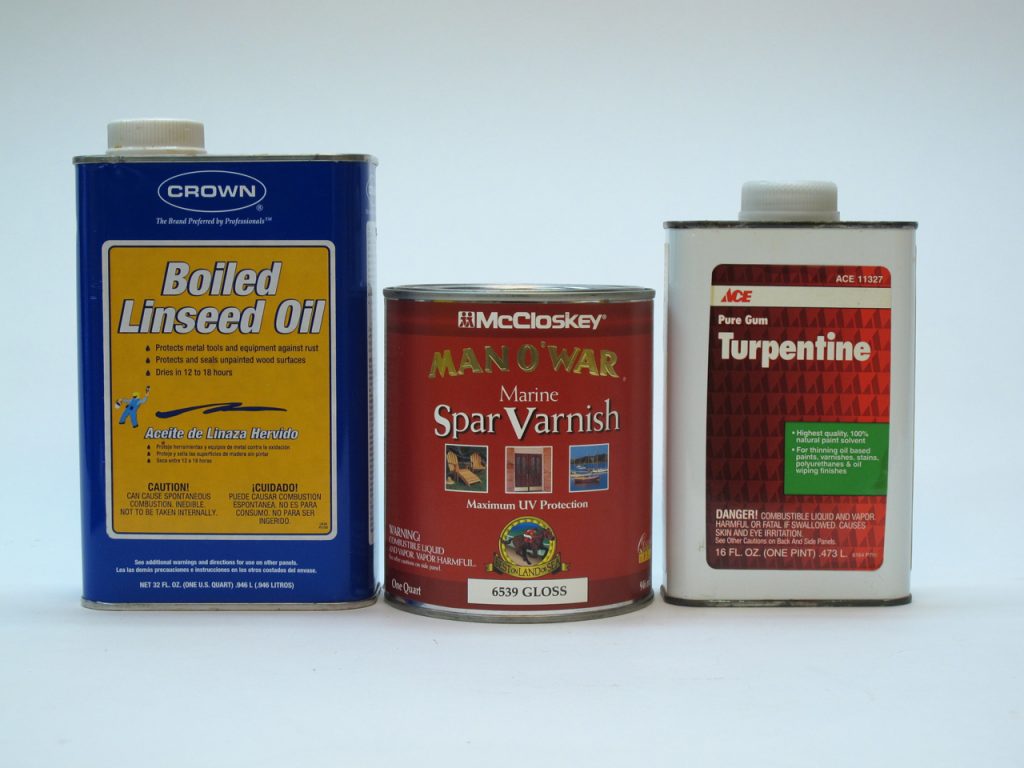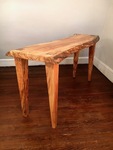We may receive a commission when you use our affiliate links. However, this does not impact our recommendations.

The ingredients for the secret formula.
Maybe you’ve had this happen to you. It’s happened to me at least four times. By the fourth I had recognized the pattern and I blew the guy’s mind.
As I’ve pointed out many times, finishes targeted at amateurs and small shops are made difficult to understand by the poor and often inaccurate labeling from manufacturers. As a result, a lot of room is created for people to come up with their own concoctions that they may want to keep secret.
So every once in a while a guy (always a guy) would come into my shop with a furniture project for me to fix or finish. During a discussion he would mention that he knew a secret formula for a terrific finish that had been passed down in his family. The formula always turned out to be the same: boiled linseed oil, spar varnish and turpentine. One-third each.
I was amused each time because I knew this formula wasn’t so secret. I had come across it many times in the old finish books I had. The results it produces are no different than Watco Danish Oil.
Anyway, the fourth time a guy bragged to me about his family’s secret formula, I decided to have some fun. So when he told me that his formula was such a valued secret within his family that he couldn’t reveal it to me, I said, “I already know it.” And I listed the three one-third parts and watched his face go pale. I just laughed.
It’s always spar varnish! Why? I have no explanation for this, other than there seems to be some mystic (also, a lot of misunderstanding) about the word “spar.”
It’s also always turpentine, never mineral spirits. But this could be because the only thinner available at the time the secret formula got started was turpentine. Mineral spirits didn’t exist.
Just so you know, in case you haven’t thought about this, there’s no reason to use spar varnish or turpentine. The type varnish and type thinner won’t make any difference. The linseed oil determines the principal characteristic of this finish. It won’t dry hard, so all the excess has to be wiped off after each coat, and what remains should be allowed to dry at least overnight.
The way to tweak the formula would be to reduce the amount of oil a lot to increase the gloss a little, assuming you’re using a gloss varnish.
Here are some supplies and tools we find essential in our everyday work around the shop. We may receive a commission from sales referred by our links; however, we have carefully selected these products for their usefulness and quality.










Actually, I’ve never been interested in trying to make my own finishes. Store-bought ones are quite good. It’s not the formulators who are the problem. It’s the marketers. Also, there are safety issues with trying to make your own varnish or lacquer.
What I remember, from long ago, is that Jere Osgood’s formulation was (my mnemonic): O-V-T, 1-2-3, that is, one part oil, two parts varnish, three parts turps. After some foul smelling ersatz turpentines, I have come to appreciate the sweet smelling real thing. L
I am enrolled in a community college Professional Crafts program for fine furniture making. One of the most popular finishes we students use for interior furniture is 3:2:1. It’s 3 parts mineral spirits, 2 parts commercial finish (we usually use wipe-on polyurethane, spar varnish, or lacquer. The 1 is boiled linseed oil. Normal application is 4 coats just like you mention–wipe it on, then wipe off excess in 15-30 minutes–and let it dry 24 hours or until dry to the touch. We will keep as our secret our foolproof method of mixing it in perfect proportions.
In your “secret formula” there may be circumstances where “spar” varnish is, in fact, important: marine varnishes, including those denominated “spar” varnishes include ultraviolet light inhibitors that may be important in some work where the piece is likely to be exposed to sunlight or other uv sources.
As an aside, no self-respecting boat person making a living finishing boats and/or boat components would use your illustrated version of “spar” varnish. If you have to stand behind your work, you would choose Epiphanes or International’s Captain’s varnish, which have far higher levels of uv inhibitors.
Fair winds and following seas,
Jim
I’d love to see an exploration of “make your own” finishes, especially in this age of uncertainty with packaging labels. Can we go beyond mixing pre-made components? Are there ways to make varnish from scratch, or is that a chemical black hole not worth diving into? Can lacquer be created at home, or is that riskier than starting an illicit drug lab? Could be a fun article or two.